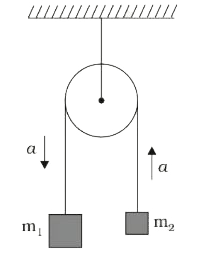The centre of mass of a system of two particle of masses m1andm2 is at a distance d1 from mass m1 and at a distance d2 from mass m2 such that.
d1d2=m2m1
d1d2=m1m2
d1d2=m1m1+m2
d1d2=m2m1+m2
The correct Answer is:a
To solve the problem regarding the center of mass of a system of two particles with masses m1 and m2, and their respective distances d1 and d2 from the center of mass, we can follow these steps:
1. Understanding the System:
We have two particles with masses m1 and m2. The center of mass (CM) of the system is located at a certain point, which we will denote as the origin (0,0) for simplicity.
2. Positioning the Masses:
Let's place mass m1 at position −d1 on the x-axis and mass m2 at position d2 on the x-axis. The distances d1 and d2 are measured from the center of mass to each mass.
3. Equation for Center of Mass:
The formula for the center of mass of a two-particle system in one dimension is given by:
xcm=m1⋅(−d1)+m2⋅d2m1+m2
Since we have defined the center of mass to be at the origin, we set xcm=0.
4. Setting Up the Equation:
Substituting xcm=0 into the equation gives:
0=m1⋅(−d1)+m2⋅d2m1+m2
This simplifies to:
m1⋅(−d1)+m2⋅d2=0
5. Rearranging the Equation:
Rearranging the above equation leads to:
m2⋅d2=m1⋅d1
6. Finding the Ratio:
Dividing both sides by m1⋅m2 gives:
m2m1=d1d2
7. Conclusion:
Thus, the relationship between the masses and the distances from the center of mass is:
m2m1=d1d2
This indicates that the ratio of the masses is equal to the ratio of their distances from the center of mass.
We have two particles with masses m1 and m2. The center of mass (CM) of the system is located at a certain point, which we will denote as the origin (0,0) for simplicity.
Let's place mass m1 at position −d1 on the x-axis and mass m2 at position d2 on the x-axis. The distances d1 and d2 are measured from the center of mass to each mass.
The formula for the center of mass of a two-particle system in one dimension is given by:
xcm=m1⋅(−d1)+m2⋅d2m1+m2
Since we have defined the center of mass to be at the origin, we set xcm=0.
Substituting xcm=0 into the equation gives:
0=m1⋅(−d1)+m2⋅d2m1+m2
This simplifies to:
m1⋅(−d1)+m2⋅d2=0
Rearranging the above equation leads to:
m2⋅d2=m1⋅d1
Dividing both sides by m1⋅m2 gives:
m2m1=d1d2
Thus, the relationship between the masses and the distances from the center of mass is:
m2m1=d1d2
This indicates that the ratio of the masses is equal to the ratio of their distances from the center of mass.
Topper's Solved these Questions
- SYSTEM OF PARTICLES AND ROTATIONAL MOTIONSBook:NCERT FINGERTPS ENGLISHChapter:SYSTEM OF PARTICLES AND ROTATIONAL MOTIONSExercise:MOTION OF CENTRE OF MASS
Explore 10 Videos
- SYSTEM OF PARTICLES AND ROTATIONAL MOTIONSBook:NCERT FINGERTPS ENGLISHChapter:SYSTEM OF PARTICLES AND ROTATIONAL MOTIONSExercise:TORQUE AND ANGULAR MOMENTUM
Explore 11 Videos
- SYSTEM OF PARTICLES AND ROTATIONAL MOTIONSBook:NCERT FINGERTPS ENGLISHChapter:SYSTEM OF PARTICLES AND ROTATIONAL MOTIONSExercise:NCERT Exemplar
Explore 8 Videos
- PRACTICE PAPERSBook:NCERT FINGERTPS ENGLISHChapter:PRACTICE PAPERSExercise:All Questions
Explore 150 Videos
- THERMAL PROPERTIES OF MATTERBook:NCERT FINGERTPS ENGLISHChapter:THERMAL PROPERTIES OF MATTERExercise:Assertion And Reason
Explore 10 Videos
Similar Questions
Two bodies of masses m1andm2(<m1) are connected to the ends of a massless cord and allowed to move as shown in figure. The pulley is both massless and frictionless. The acceleration of the centre of mass is (m1−m2)n(m1+m2)2g. Find the value of n.

View SolutionCalculate the position of centre of mass of a system consisting of two particles of masses m_1 and m_2 separated by a distance L apar, from m_1?
View Solution
Knowledge Check
The reduce mass of two particles having masses m and 2 m is
A2 mB3 mC2 m/3Dm/2
Consider a system of two particles having masses m1 and m2. If the particle of mass m1 is pushed towards the centre of mass of particles through a distance d, by what distance would the particle of mass m2 move so as to keep the mass centre of particles at the original position?
View SolutionThere are two masses m1 and m2 placed at a distance l apart. Let the centre of mass of this system is at a point named C. If m1 is displaced by l1 towards C and m2 is displaced by l2 away from C. Find the distance, from C where new centre of mass will be located.
View SolutionConsider a sytem of two particles having masses m1 and m2. If the particle of mass m1 is pushed towards the centre of mass of particles through a distance d, by what distance would the particle of mass m2 move so as to keep the mass centre of particles at the original position?
View SolutionConsider a two particle system with the particles having masses m1andm2. If the first particles pushed towards the centre of mass through a distance d, by what distance should the second particle be moved so as the keep the centre of mass at the same position?
View SolutionMass centers of a system of three particles of masses 1,2,3kg is at the point (1m,2m,3m) and mass center of another group of two partices of masses 2kg and 3kg is at point (−1m,3m,−2m). Where a 5kg particle should be placed, so that mass center of the system of all these six particles shifts to mass center of the first system?
View SolutionA praticle of mass M at rest decays into two particle of masses m1 and m2, having non-zero velocities. The ratio of the de Broglie wavelength of the particles λ1λ2 is
View SolutionConsider a system of two particles having masses 2kg and 5 kg the particle of mass 2 kg is pushed towards the centre of mass of particles through a distance 5 m,by what distance would particle of mass 5kg move so as to keep the centre of mass of particles at the original position?
View Solution

